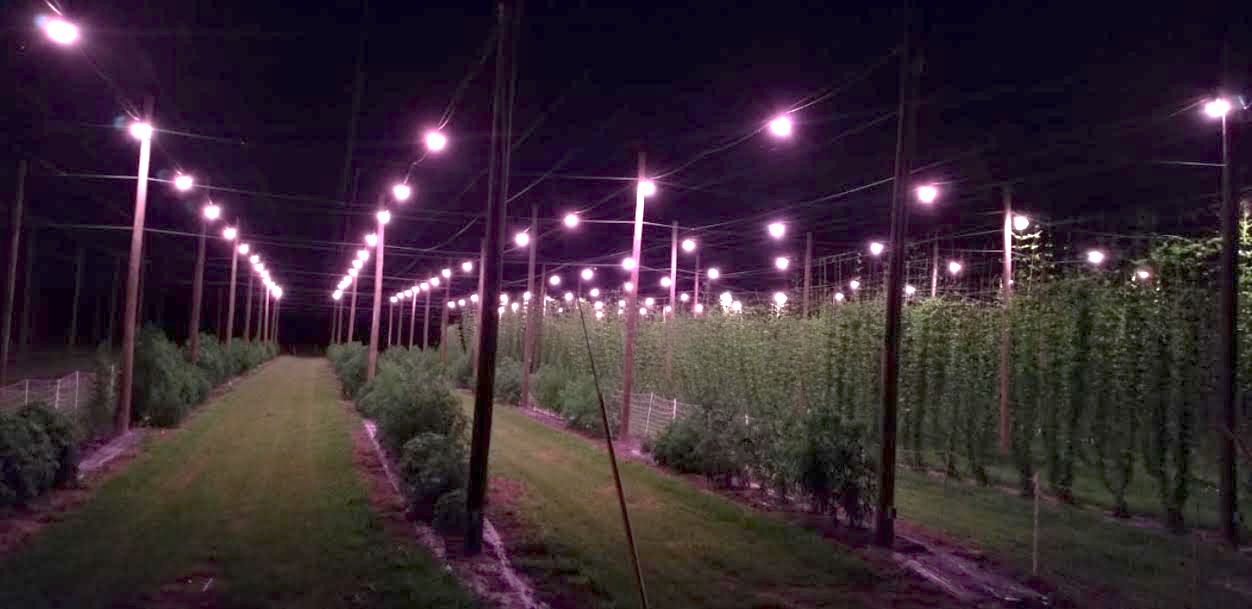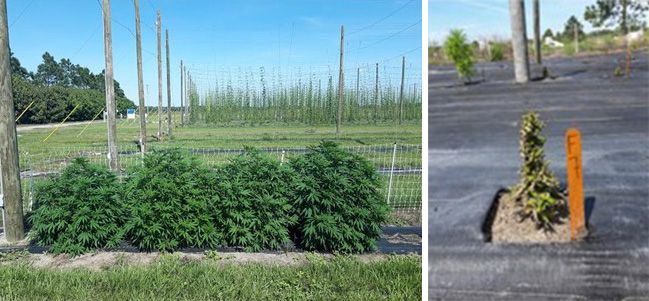With the removal of hemp (Cannabis sativa L.) from the controlled substances list (2018 Farm Bill and 2019 Florida Statute, SB1020), hemp is now one of the emerging crops in Florida. There is limited information on how to grow this crop in Florida. Like hops, hemp is another recently introduced crop in the state, with one of the major yield-limiting factors of premature flowering induced by inadequate day length. This article provides guidelines for hemp growers in Florida on the use of supplemental lighting to control flowering and improve growth of hemp under Florida’s environmental conditions.
Introduction
Hemp is now an agricultural commodity in Florida, and interest among Florida growers is high. Hemp is a very versatile crop and different parts of this plant are harvested for specific purposes. Fiber hemp cultivars are known to have tall, preferably slender stalks and can grow anywhere from 1 to 5 m (3–15 ft) in height. Clothing, rope, housing materials, compost, and paper are a few items that can be made from just the stalk of fiber hemp plants (Cherney and Small 2016). There is great potential in fiber hemp products to be used as eco-friendly alternatives or replacements for construction materials and plastics in the future.
Grain hemp cultivars are plants that produce a high density of seeds that can be used to make a multitude of products, including food items, animal feed, and cosmetics (Cherney and Small 2016). These plants do not grow as tall as fiber plants, usually averaging 3 to 7 ft in height. Dual-purpose cultivars tend to produce a large number of seeds to use for hemp grain products, but they also have tall stalks suitable for fiber production. Therefore, both grains and stems are commonly harvested from dual-purpose hemp cultivars (Hinterthuer 2015).
Another type of hemp is bred and cultivated for essential oils, or more specifically cannabidiol (CBD). This type of hemp is usually shorter and more branchy than fiber and dual-purpose hemp cultivars. CBD is a nonpsychoactive compound, although it resembles tetrahydrocannabinol (THC) contained in marijuana. CBD can be obtained from the dried flower material by extraction or vaporization processes. CBD products include topicals, edible forms, and smokable products, and it is used medicinally to curb anxiety, pain, and cognitive disorders, as well as to aid in sleeping (Grinspoon 2018). CBD is highly concentrated in unfertilized female flowers, with much lower concentrations in roots, vegetative plant tissues, and pollens and seeds (Hinterthuer 2015).
Cannabis and Daylength
Hemp and hops (Humulus lupulus L.) belong to the Cannabaceae family. Both plants are dioecious, meaning they have separate male and female plants. Their flowering is dependent on day length. Hemp and hops are known as short-day plants (Thomas and Schwabe 1969) because they flower when day length drops below a certain threshold, which is about 15 to 16 h. Day length is a function of latitude, and because Florida’s latitude ranges between 24°30’N and 31°N, day length rarely exceeds 14 hours anywhere in the state. This means that plants like hemp and hops tend to flower prematurely under Florida’s natural day length, especially in spring and fall, which is a major yield-limiting factor.
Hop plants grown under Florida’s natural day length have shown limited vegetative growth and yields (Agehara et al. 2021). Therefore, the research hopyard at the UF/IFAS Gulf Coast Research and Education Center (GCREC) is currently equipped with LED supplemental lights to manipulate day-length conditions (Figure 1). The LED lights used in the hopyard are the Philips GreenPower LED flowering lamp DR/W, for which the light emission spectrum is between 400 and 700 nm (Agehara 2020). In this hopyard, photoperiod extension (>17 hours of day length) is used during the vegetative growth stage to inhibit premature flowering (Agehara 2020). When optimum vegetative growth is achieved, flowering is induced by turning off supplemental lighting (Agehara 2020). This flowering control strategy enables double-season production of hops in a subtropical climate (Agehara et al. 2021). The video describing spring and fall growth cycles of hops in Florida is available at https://youtu.be/_rAnXr3cQrs.

Credit: J. Coburn, UF/IFAS
While growing hemp in summer (planting around May) is possible in Florida, there are many issues during this time in relation to pest and disease pressure (e.g., bud rot) because of high heat and rainfall, as well as potential hurricane damage. Also, summer is typically the time when hemp is grown in northern states. If Florida could provide hemp products outside the growing season of other states, similar to vegetables, which are grown in fall and spring (between September and June), this would be a significant competitive advantage.
To evaluate whether the supplemental lighting program used for hop production is also effective for hemp production, we compared hemp growth with and without supplemental lighting at the UF/IFAS GCREC.
Hemp Growth with and without Supplemental Lighting
Eight hemp cultivars from Europe, China and the United States, consisting of fiber, dual and CBD types (Tygra, Eletta Campana, Carmagnola Selezionata, Bama, Yuma, Puma-3, Cherry Blossom × T1, and Cherry Blossom), were planted at the UF/IFAS GCREC farm in Balm, FL in October 2019 (fall crop) and February 2020 (spring crop) with and without supplemental lighting (Table 1).
Table 1. The primary use and geographical origin of hemp cultivars grown at the UF/IFAS GCREC in fall 2019 and spring 2020.
The treatment plots with supplemental lighting were set up on empty rows in the hopyard at the UF/IFAS GCREC. The hopyard was equipped with LED lights (GreenPower LED flowering lamp DR/W, Philips, spectrum 400–700 nm) installed at 5.5 m above the ground and spaced 20 feet apart in a staggered pattern (Agehara 2020). Photoperiod extension was performed from 6 p.m. to midnight during the first two to three months after transplanting for both fall and spring crops, respectively 86 days and 73 days. For more information on the supplemental lighting program, see https://edis.ifas.ufl.edu/publication/HS1365 (Agehara 2020). The control plots without supplemental lighting were set up about 300 ft from the treatment plots to avoid the exposure to supplemental lighting. Both plots with and without lighting received the same irrigation and fertigation regime.
Supplemental lighting greatly increased the overall plant development of all hemp cultivars as compared to natural Florida day-length conditions (Figure 2). In the fall, onset of anthesis (flowering) for all plants in the area without supplemental lighting occurred within 20 days after transplanting, as compared to up to 67 days when supplemental lighting was used. In the spring, without supplemental lighting all cultivars flowered within 27 days as compared to up to 91 days with supplemental lighting (Table 2). Flowering in both seasons did not begin until the lights were turned off for all cultivars except for those of European origin (Tygra, Eletta Campana, Carmagnola Selezionata). Some cultivars had plants that did not transition to reproduction at all (Bama, Yuma-2, Puma-3), even after 3 months.

Credit: J. Coburn, UF/IFAS
Without supplemental lighting, hemp growth was very poor for all cultivars in both seasons. Contrastingly, hemp planted in the area with supplemental lighting grew very well as vegetative growth was maintained through the day-length extension period. Plant height in the area without supplemental lighting averaged around 25 cm (1 ft) for the CBD cultivars and 50–100 cm (2–3 ft) for the fiber and dual cultivars, irrespective of the season (Table 3). By contrast, with supplemental lighting, plants grew 2–4 times taller, with the greatest height growth occurring for the spring planting (Table 3).
Accordingly, biomass production was extremely poor without supplemental lighting in both seasons (20 g dry weight or less) (Table 3). When supplemental lighting was used, plant dry weight increased 10-fold for the fall planting and up to 200-fold for the spring planting (Table 3).
Table 2. Time of flowering (days after planting) of hemp cultivars with and without supplemental light (UF/IFAS GCREC, Wimauma, FL).
Table 3. Plant heights (cm) of hemp cultivars with and without supplemental light (UF/IFAS GCREC, Wimauma, FL).
Table 4. Total plant dry weights (g) of hemp cultivars with and without supplemental light (UF/IFAS GCREC, Wimauma, FL).
Our study shows that hemp, like hops, can be productively grown and harvested twice a year in Florida when supplemental lighting is used to achieve optimum vegetative growth before flowering. Hemp is most productive when planted in late winter to early spring, whereas moderate yields can be expected for fall plantings.
While no economic analysis has been done yet, the ability to grow two productive crops of hops and hemp simultaneously using the exact same light setup and regime means that the investment for building a hopyard or installing supplemental lighting could be recuperated much faster. Intercropping of hemp and hops could therefore provide new opportunities for a wide range of small to mid-size farmers who are looking to diversify or start a potentially lucrative new operation.
Literature Cited
Acosta-Rangel, A., J. Rechcigl, S. Bollin, Z. Deng, and S. Agehara. 2021. “Hop (Humulus lupulus L.) Phenology, Growth, and Yield under Subtropical Climatic Conditions: Effects of Cultivars and Crop Management.” Aust. J. Crop Sci. 15:764–772. https://doi.org/10.21475/ajcs.21.15.05.p3192
Agehara, S. 2020. “Using Supplemental Lighting to Control Flowering of Hops in Florida.” EDIS 2020 (2). HS1365. https://doi.org/10.32473/edis-hs1365-2020
Agehara, S., M. Gallardo, A. Acosta-Rangel, Z. Deng, J. Rechcigl, T. Luo, and Q. Qiu. 2021. “Crop Management Practices and Labor Inputs for Hop Production in Florida.” EDIS 2021 (2). HS1409. https://doi.org/10.32473/edis-hs1409-2021
Cherney, J., and E. Small. 2016. “Industrial Hemp in North America: Production, Politics and Potential.” Agronomy 6 (4): 58. https://doi.org/10.3390/agronomy6040058
Grinspoon, P. 2018. “Cannabidiol (CBD)—What We Know and What We Don’t.” Harvard Health Blog. https://www.health.harvard.edu/blog/cannabidiol-cbd-what-we-know-and-what-we-dont-2018082414476
Hinterthuer, A. 2015. The Emerging (Re) Interest in Industrial Hemp. CSA News 60 (6): 4–9. https://doi.org/10.2134/csa2015-60-6-1
Thomas, G. G., and W. W. Schwabe. 1969. "Factors Controlling Flowering in the Hop (Humulus lupulus L.)." Ann. Bot. 33 (4): 781–793. https://doi.org/10.1093/oxfordjournals.aob.a084324